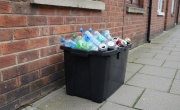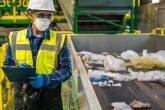Waste intensity falling in EU, but member states advised to tighten regulation
European Environment Agency report finds that while waste intensity has decreased by 13 per cent since 2010, Member States are failing to utilise regulatory instruments to prevent rising waste volumes.
European Union (EU) Member States are largely relying on voluntary initiatives and information campaigns to reduce waste, instead of using regulatory or market-based policy, according to a new report from the European Environment Agency (EEA).
The ‘Preventing waste in Europe - Progress and challenges, with a focus on food waste’ report gives insights on waste prevention actions supported by the EU’s Waste Framework Directive (WFD).
The report outlines that while waste intensity - waste generated per unit of economic activity (kgs of waste per GDP EUR)- has decreased by 13 per cent since 2010, total waste generation remains high with absolute waste volumes continuing to rise.
Lack of transparency over waste prevention policies and the underutilisation of regulation are highlighted as key reasons for the increase in waste generation, with the report calling for a more balanced approach that strengthens economic incentives and regulatory approaches to ‘enhance the effectiveness of waste prevention efforts’.
National Waste Prevention Programmes (WPPs)
The WFD requires EU Member States to implement national Waste Prevention Programmes (WPPs), aimed at curbing waste generation at the source. However, the EEA’s report identifies significant gaps in these programmes, particularly in the type of policy instruments used.
The majority of the WWPs encourage reuse, repair and sustainable consumption models, alongside food waste prevention. However, other measures, such as reducing the amount of hazardous substances in materials and products, have only been adopted in just over half of the Member States.
81 per cent of measures rely on voluntary initiatives, public awareness campaigns and industry agreements. Regulatory and market-based instruments, such as financial incentives, taxes and extended producer responsibility (EPR) schemes remain underutilised, says the report.
The table below outlines the number of EU Member States that have incorporated WFD measures into their WWPs, and what percentage of those measures use regulatory, market-based, or voluntary policy instruments.
| WFD measure | Share of EU-27 Member States’ WPPs with the measure | Regulatory policy | Market-based policy | Voluntary initiatives or agreements |
|---|---|---|---|---|
| Sustainable consumption models | 96% | 26% | 41% | 74% |
| Encourage resource-efficiency, durability, reparability, reusability, and upgradability | 89% | 11% | 15% | 78% |
| Target products containing critical raw materials | 76% | 22% | 0% | 56% |
| Encourage reuse and repair | 100% | 26% | 41% | 96% |
| Encourage availability of spare parts, instruction manuals | 59% | 15% | 4% | 33% |
| Reduce waste generation in industrial production, mineral extraction, manufacturing and construction | 93% | 33% | 30% | 70% |
| Reduce food waste generation | 93% | 44% | 7% | 81% |
| Encourage food donation and redistribution | 78% | 15% | 15% | 59% |
| Promote the reduction of the content of hazardous substances in materials and products | 59% | 22% | 4% | 44% |
| Reduce the generation of waste not suitable for reuse or recycling | 70% | 15% | 15% | 44% |
| Identify products that are the main source of littering and take measures to prevent/reduce litter | 78% | 52% | 11% | 63% |
| Aim to half generation of marine litter | 59% | 19% | 4% | 41% |
Table 1: Percentage of EU-27 countries incorporating categories of measures from WFD Article 9(1) into their WPPs
Furthermore, while Member States are required to evaluate their WPPs every six years, the report finds that many evaluations lack transparency and clear impact assessments. Without access to reporting, the effectiveness of these programmes is difficult to assess.
Food waste prevention
The report highlights slow progress towards the EU’s target to reduce food waste by 10 per cent in processing and manufacturing, and 30 per cent in retail and consumption.
According to the EEA, most food waste measures - around 62 per cent - focus on awareness campaigns, with even fewer regulatory or economic incentives in place.
While recent efforts have improved monitoring mechanisms, gaps in food waste data collection remain, making it difficult to track progress effectively. The report advocates for more measurement systems to support policy decisions and to ensure that food waste reduction efforts align with broader sustainability goals.
It also argues for the prioritisation of food waste redistribution, so that surplus food is donated or used as animal feed instead of recycled or disposed.
Recommendations
To address the issues with waste prevention, the EEA proposes a series of recommendations aimed at improving the effectiveness of policy:
- Diversity policy instruments: A more balanced approach that combines regulation, market incentives and voluntary actions is needed.
Improve data collection and transparency: Strengthening reporting requirements and impact assessments to identify successful strategies and areas that need improvement. - Integrate waste prevention with circular economy strategies: Waste prevention needs to be embedded in broader circular economy policies, aligning with climate goals, biodiversity protection, and sustainable consumption initiatives.
- Enhancing food waste prevention: Member States should adopt more ambitious food waste reduction policies, including financial incentives for redistribution and stricter regulations to limit food waste at retail and consumer levels.
Alongside this, the authors note there is scope for the EU to go further and play a broader national waste reduction measures, arguing that it could offer more guidance on how to integrate policies into their national energy and climate plans.








